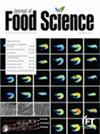Gluten-free diets are characterized by lower nutritional quality. The use of green plantain flour in gluten-free formulations appears as an alternative to overcome this deficiency, considering that green plantains have a relevant content of bioactive compounds, dietary fiber, including resistant starch. The objective of this work was to evaluate the effect of the addition of native and modified by hydrothermal treatment green plantain whole flours in the form of gluten-free cupcakes. The density, yield, and microstructure of the dough, specific volume (SV), height, crumb analysis, color, texture, and sensory acceptability of the cupcakes were evaluated. Partial replacement (40%) of rice flour by native and modified flours produced darker, redder cupcakes, less yellowish and with less color intensity. Sensory analysis revealed higher acceptance for cupcakes with native and modified flours, compared to the control, for appearance, flavor, texture, aroma, and overall acceptance. The native flour was the most viable option, as the cupcake produced with it showed the best values for hardness and chewiness, without changing elasticity and SV, in addition to superior sensory acceptance than the control and similar to cupcakes with other modified flours.
Pursuing to meet the market demand for gluten-free products, with the cake being one of the most requested products in this market, and taking in account that green banana, from different cultivars, has gained interest for the production of flours. The production of flour and bakery products is of great interest to the food industry, not only because of its flavor and properties but also due to the economic and sustainable viability of producing whole green plantain flour with the potential for application, promoting diversification and innovation in the gluten-free functional products market.


